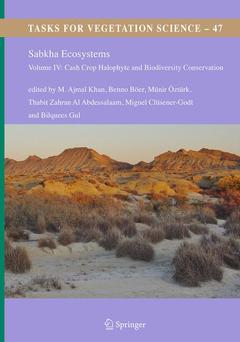Sabkha Ecosystems, 2014 Volume IV: Cash Crop Halophyte and Biodiversity Conservation Tasks for Vegetation Science Series, Vol. 47
Coordonnateurs : Khan M. Ajmal, Böer Benno, Öztürk Münir, Al Abdessalaam Thabit Zahran, Clüsener-Godt Miguel, Gul Bilquees

Sustainable development is the key for the survival in 21st century. The natural resources are finite and cannot be used with impunity because we are the custodian of these resources and have responsibility to pass these to the next generation. This monumental task requires several major commitments and most important of them is to arrest population explosion which has already reached seven billion. Natural resources like air to breath, food to eat, and water to drink, and fossil fuel to maintain this life style are being overexploited. Unrestrained consuming culture will accelerate undesired situation. This situation will have more dire consequences in resource limited ecosystems like dry lands. Given the severe scarcity of water, ever increasing population and soil salinization out of the box solutions for the provision of food and clean energy is required to spare meager fresh water resources for conventional agriculture. This volume contains a number of articles dealing with halophyte ecology, bio-geography, ecophysiology, hyper-saline soils, biofuels, biosaline agriculture, biosaline landscaping, climate change mitigation, and biodiversity. It also contains the communication of innovative ideas, such as the research into floating mangroves, seagrass terraces, as well as a World Halophyte Garden containing all known salt-tolerant plant species. It is hoped that the information provided will not only advance vegetation science, but that it will truly generate more interdisciplinarity, networking, awareness, and inspire farmers, and agricultural and landscaping stakeholders to seriously engage in halophyte cash crop production in coastal hyper-saline areas.
List of Authors.- Preface.- Foreword.- Acknowledgements.- Introduction.- 1. Economic sustainability for halophyte cash farms in urban environments.- 2. Spatial distribution of soil salinity and its management options in the Northern Emirates, UAE.- 3. Gypsum crystals formation and habits, Umm Said sabkha, Qatar.- 4. Distribution, ecology and ecophysiology of mangroves in Pakistan.- 5. Halophytes for the production of liquid biofuels.- 6. Feasibility of halophyte domestication for high-salinity agriculture.- 7. The gypsum dunes of Cuatrociénegas Valley, Mexico – A secondary Sabkha ecosystem with gypsophytes.- 8. Effects of seed storage on germination of desert halophytes with transient seed bank.- 9. Halophytes of southwest Asia.- 10. From halophyte research to halophytes farming.- 11. Interactive effect of salinity and drought on the germination of dimorphic seeds of Suaeda salsa.- 12. Kochia (Kochiascoparia (L.) Schrad) unwanted or wanted plant for forage production in harsh environments.- 13. Importance of the diversity in between halophytes to agriculture and land management in arid and semiarid countries.- 14. Is soil heterogeneity the major factor influencing vegetation zonation at Karachi coast?.- 15. Research and development with seawater and halophytic plants for sustainable saline agro systems in the Arabian Gulf.- 16. Salinity tolerant turfgrasses for biosaline urban landscape agriculture.- 17. Ecology, distribution and ecophysiology of Salicornia Europaea L..- 18. Germination pre-treatments in Haloxylon persicum (Amaranthaceae), an economically important tree of desert ecosystems in western Asia.- 19. Halophytes in the east Mediterranean – their medicinal and other economical values.- 20. Germination and early seedling growth of two salt-tolerant Atriplex species that prevent erosion in Iranian deserts.- 21. Salt marshes and biodiversity.- 22. Distinctive features and role of sulfur-containing compounds inmarine plants, seaweeds, seagrasses and halophytes from an evolutionary point of view.- 23. The chemical composition and technological properties of seagrasses – a basis for their use (a review).- 24. Seagrass terraces for food security and carbon sequestration.- 25. Floating mangroves: the solution to reduce atmospheric carbon levels and land-based marine pollution?.- 26. World Halophyte Garden: Economic dividends with global significance.- Index.
Date de parution : 10-2016
Ouvrage de 339 p.
17.8x25.4 cm
Date de parution : 05-2014
Ouvrage de 339 p.
17.8x25.4 cm
Thèmes de Sabkha Ecosystems :
Mots-clés :
Biodiversity; Cash crop; Dry lands; Halophytes; Saline ecosystem



